

Prior Episodes | 7955 (22 BBY) | Next Episodes
Continuity & Analysis
Star Wars: The Clone Wars - Cat and Mouse (2010) [S2E16]
A wise leader knows when to follow.
"An impenetrable defense! Separatist ships blockade the resource-rich planet of Christophsis,
trapping Senator Bail Organa and his relief effort. Desperate to aid the esteemed Senator,
a Republic task force under the command of Jedi Knight, Anakin Skywalker must break the impasse.
But time runs short for the Senator and the good citizens of Christophsis..."
Star Wars: The Clone Wars - The Hidden Enemy (2009) [S1E16]
Truth enlightens the mind, but won't always bring happiness to your heart.
"A planet under siege! Separatist forces mercilessly batter the beautiful and elegant world of Christophsis.
Unable to defend themselves any longer, the people of Christophsis call upon the Jedi for assistance.
Hoping to save lives and prevent further destruction, Obi-Wan Kenobi and Anakin Skywalker
plan a daring ambush which can turn the tide in the fight for this crucial star system..."
Star Wars - The Clone Wars (2008) [Film]
"A galaxy divided! Striking swiftly after the Battle of Geonosis, Count Dooku's droid army has
seized control of the major hyperspace lanes, separating the Republic from the majority
of its clone army. With few clones available, the Jedi generals cannot gain a foothold
on the Outer Rim as more and more planets choose to join Dooku's Separatists.
While the Jedi are occupied fighting a war, no one is left to keep the peace.
Chaos and crime spread, and the innocent become victims in a lawless galaxy.
Crime lord Jabba the Hutt's son has been kidnapped by a rival band of pirates.
Desperate to save his son, Jabba puts out a call for help - a call the Jedi are cautious to answer..."


CONTINUITY
These two episodes and The Clone Wars film form a single storyline about the Battle of Christophsis, and the political
intrigue involving the Hutts and their territory. The chronological order of episodes is as given by Lucasfilm.
The planets Christophsis and Teth are seen for the first time. Four worlds are seen in these episodes and this film:
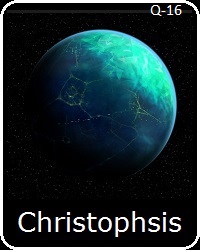
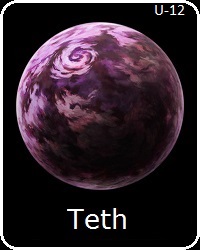


- Christophsis is an ecumenopolis, or "city-world", in the Savareen Sector, within the Slice region of the Outer Rim, located along the important Corellian Run,
one of the galaxy's major hyperlanes. While there are a number of these totally urbanized worlds in the Core regions, they are few and far between in
the Rim. From orbit, it does not appear this planet is totally covered in city like Coruscant, rather the urban areas are concentrated in clusters, which
branch out and run continuously into other clusters, forming a single urban area which covers the entire planet. Coruscant is the oldest and most layered
of the city-worlds, and no other world really comes close in terms of total urbanization and height of structures above the surface. Despite this, a world like
Christophsis has a massive population, and obviously a long history. Considering its location, and that it was a colony world that was built up from nothing,
the achievement is all the more impressive. The resource wealth of the planet, and the profits it generated, is likely responsible for its well-developed state.
The population is primarily Human, who are usually recognizable by their unusual, orange complexion, the result of adapting to the conditions on the planet.
Main Article: Galactic Population

- Anakin immediately senses Obi-Wan when his destroyer enters the star system, another example of his powerful Force sense, and the strong connection they share.

The stealth ship used in this episode was a good storytelling device, but an extremely problematic one. This is one of two
examples of Star Trek-style 'invisible to the eye' cloaking devices that have yet been seen, and both are major continuity
issues. As discussed in the previous episodes, and the main article about cloaking devices, their mention in Episode V
suggests cloaking devices hide ships from tracking systems, not make them invisible to someone looking out a window.
Even if the ship based systems are able to blind visible light sensors, the ships should be visible to the naked eye.
Nevertheless, Lucas clearly allowed this as executive producer, but that still does not address the issue that cloaking
devices are too large or energy intensive for small ships, mentioned in this episode in reference to the statement in
Episode V. Mentioning it actually makes this continuity issue much worse. If these cloaking devices make ships
invisible to the naked eye, why aren't most large ships in SW using them? The attempt to explain this ship, which is small
and can cloak, by suggesting it is a prototype also makes this worse. The ship performed quite well, so the Republic
should have been manufacturing and using them everywhere, and the Empire as well. Yularen mentioned that Trench
alone had a history which included a few battles against ships with cloaking devices. If they are that common, why are
they never seen again anywhere in SW. Adding more of them would only make this issue worse, it is simply
a game-changing technology that would become omnipresent, and should have been that way all along.
Main Article: Scanners, Sensors, and Cloaking Devices
- Clone trooper CT-1284 Spark is referred to as a rookie, and is replacing a lost team member in a special forces unit. In Episode II we are told that 200,000 clones were
already ready, with a million more on the way. That conversation was at most a few months earlier, but probably more like a month or two. Even if Spark was only
new to the team and had been part of the original group of finished clones, nearly every clone that is identified at any point has a CT or CC number less than 10,000.
Later episodes will introduce the idea that part of a clone's number used in training is dropped when the graduate, as Fives was CT-27-5555 in training, and later
is called both ARC-555 and CT-5555. That strange theory may explain some of this, but also renders the system bulky and pointless. There would be dozens or
potentially hundreds of soldiers with the same CT number, making them of limited use as a unique identifier. It is likely it was decided clone designations
shouldn't be particularly long, and the system as a whole was never considered. The fact that birth numbers read like droid designations is a direct comparison
between the battle droids, which serve the Sith in this war, and the programmed clone soldiers, which ultimately serve the Sith as well.
Main Article: Dooku, Sifo-Dyas, and the Clone Army
- Days are called rotations because days are of different lengths relative to the rotational speed of a given planet. When a character gives a time in rotations, we have
no way of knowing if they mean galactic standard Coruscant rotations, the rotations on the planet in particular, or some other standard for giving rotations.
- In keeping with his character, Anakin follows the letter of the law then does what he pleases in addition to what is required, in this case in regard to his mission to
deliver supplies to Senator Organa and the Republic forces on the surface. His desire for more, and to get what he wants is combined with his high regard for his
own ability to outmaneuver, overpower, or otherwise best his opponents, and to make things the way he wants them to be. Being restricted to the letter of his
orders is what Anakin considers holding him back. Now that he is a General and a Knight, he has greater latitude to proceed as he sees fit.

- Shields on spacecraft are shown to be weakened by resisting weapons fire, but can be regenerated to higher strength by deactivating them. Once lowered, they
cannot be instantly reactivated until they finish "cycling". The shields on Trench's destroyer have to be lowered in order to fire torpedoes. Later we see this barrier
to matter in the opposite direction, when Anakin can't land on the Republic destroyer because the "deflector shields" are still up.
Main Article: Shields, Deflectors, and Ray Shields
- The Republic's primary capital ships, the Venator-class star destroyers, are often colloquially referred to as Jedi Cruisers. The term 'cruiser' is exactly like the term
'commander' in SW: both are used generally for many different things, and specifically as a position in a hierarchy. A Commander is a specific rank in SW,
usually above Captain and Major but below a Commodore or Colonel, but 'commander' is also a term used for anyone of any rank in command of something.
Similarly, a Cruiser is a specific size of warship, based on crew compliment and armament, which is larger than a Frigate or Corvette but smaller than a Destroyer.
The term 'cruiser' can also be applied to a vast array of ships, both military and non-military, from huge battlecruisers or destroyers, like these Jedi 'Cruisers',
down to simple transports that are larger than a shuttle, such as the ubiquitous Gozanti cruisers.

- Blaster cannons are also shown to lose power, and need to cease fire in order to reset to full charge. This indicates that as an energy weapon, they don't use a unique
form of energy as ammunition, and instead draw their power from the main energy sources of the ship. The necessity to store up energy in a buffer in order to fire
the cannons means that there is a limit to how much any one cannon, or any one ship, can fire in the scope of a single engagement.

Is Cody a Captain at this point in the war, who also holds the position of unit Commander? Obi-Wan calls Cody a Captain
two lines of dialogue after he calls him his usual rank of Commander. This is claimed to be an error due to an editing
change, and the line was originally intended to be said to Rex. Nevertheless, in another scene Sgt. Slick addresses Cody as
"Captain". Since Cody is a Commander in every other appearance including later in this same battle, it is safest to assume
this is an error, however, he may technically be a Captain at this point in the war, as other clone officers of the rank of
Captain are called "Commander" when in command of a unit. This was not the intention of the creators at the time,
but there are plenty of examples where this is the case.
Main Article: Ranks and Rank Insignia
- Tactical droids are not only intelligent, their heads are full of useful knowledge necessary for them to form their strategies. The fact that this knowledge can usually
be accessed makes them prime targets for Republic intelligence gathering, which usually involves just taking the head for ease of capture. Tactical droids usually fill
the positions and ranks below the organic executive officers, but above the battle droid lieutenants and sergeants, in both the Droid Army and the Separatist Fleet.
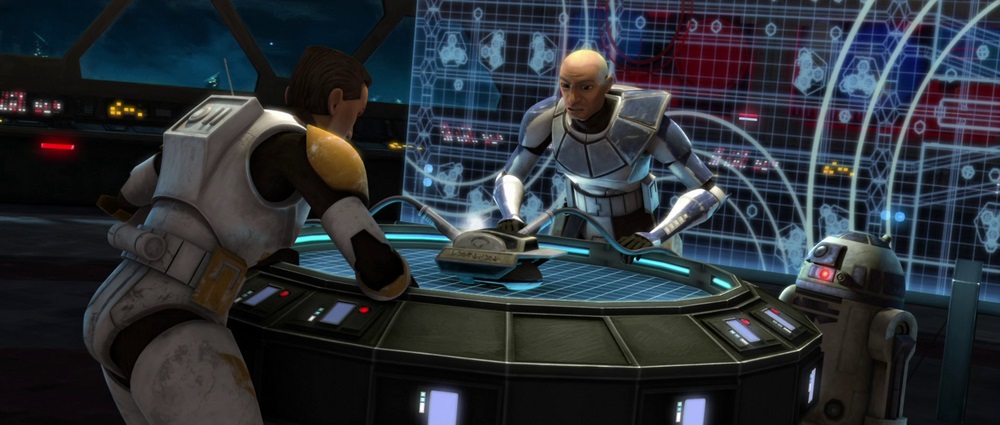
- Ventress lures the Jedi away from their troops while her agent sabotaged their weapons depot. Once her mission is complete, she boards a Trident-class
assault ship to execute the next part of Dooku's plan. This is the same ship seen in at the beginning of The Clone Wars film capturing the barge carrying
Jabba's son. The narrator implies that Jabba is under the impression that a "rival band of pirates", which is clearly part of Dooku's deception.

Obi-Wan knows Ventress' name, and she tells Obi-Wan she has missed him. When did they previously meet, and how do
the Jedi know her name at this point? She only met Anakin face to face in their first meeting, and she never gave Anakin
her name. Obi-Wan later refers to her as "that dark assassin", and this is the first time chronologically that she is seen
again. Since this is in S1E16, it might seem that the writers forgot to take into account that this takes place before
The Clone Wars film and first 15 episodes, but that isn't the case. The film was the very first installment of this series, and
Ventress and Obi-Wan are familiar already there as well. This means that there was some confrontation with her at some
point in the brief period between the Battle of Muunilinst and these episodes. It is possible the Jedi learned her name
from reports or investigation, but from their dialogue it really seems like Ventress met Obi-Wan in person once before.
- Ahsoka is considered young for Padawan, but has been promoted due to her advanced abilities. Ahsoka is fourteen, and although it is unclear exactly how Togruta
aging relates to the Human aging process at this point she seems to be the equivalent age in Togruta years of a young teenage Human. Ahsoka is considered
somewhat reckless and undisciplined, by Yoda as well as Anakin. Yoda as paired her with Anakin for both their sakes. Ahsoka, it is hoped, will be helped by
learning from a Jedi who also had advanced abilities and progressed quickly. Yoda and Obi-Wan are hoping that training a student will teach Anakin greater
maturity, responsibility, and the value of the teachings he is imparting, but most of all to teach him how to let go of those he has come to care about. Yoda
believes that if Anakin is to find balance as a Jedi, he must master this above all. It is unusual for a Jedi to be a Knight and have an apprentice at nineteen.
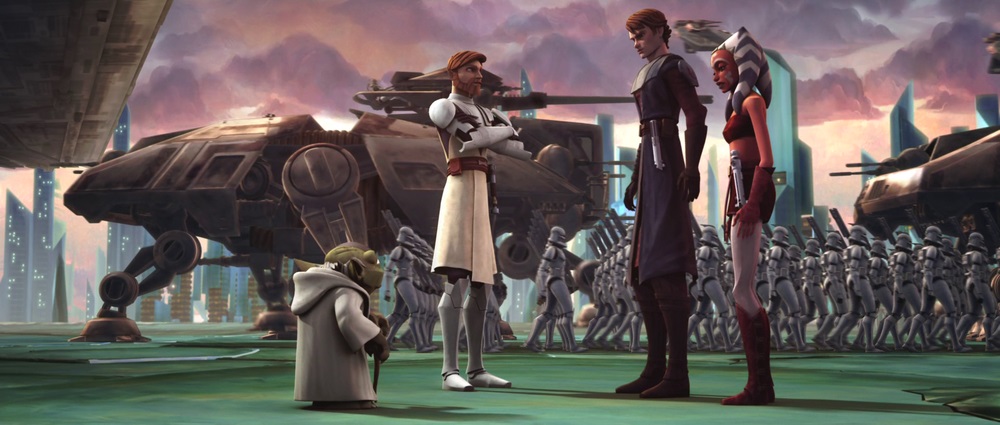
- The advancing droid army employs what is directly referred to as a "deflective energy shield", which is produced from a stationary generator and expanded to
cover their advance. Like the shields on the droideka 'destroyer' droids, slow moving or stationary objects pass through the shield, and it only protects against
energy weapons, explosives, and projectiles. The kind of shield that the starships use, which matter cannot pass through, would be impractical, of limited use,
and incredibly energy-intensive, possibly beyond the capacity to generate in most instances.
Main Article: Shields, Deflectors, and Ray Shields

- Teth is a planet in the Baxel Sector in the Slice region of the Outer Rim, on the border of Wild Space, and located along the Triellus Trade Route, a secondary
hyperlane of regional importance. Located relatively near to the outer edge of the galaxy, Teth is extremely remote. It has a small population and some
aspects of interstellar civilization, however the planet is primarily in its natural state. It has a dense ecosystem which includes jungles, and a breathable
atmosphere for most interstellar species. It is a world sometimes utilized by Hutts, as it is immediately adjacent to Hutt Space.
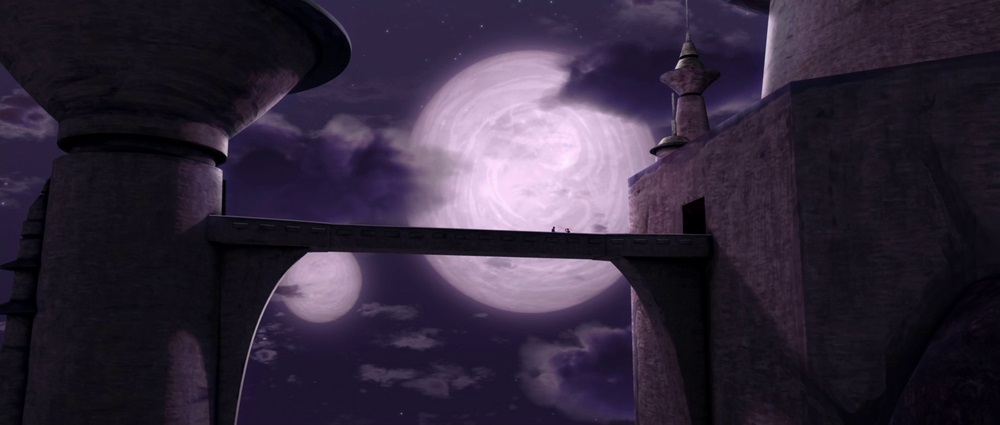
- The Ba'omar monk monastery is one example we have seen of interstellar religions that are not based on the Force. We don't learn much else about them anywhere
in the true canon of the films and shows, in part because smugglers pushed the monks out, and then the Separatists did the same to the smugglers, so the monks are
not seen. The architecture appears to be a confirmation of the non-canon material which says that Jabba's palace is a seized and repurposed Ba'omar monastery.
- The Republic tank walkers make a vertical assault up a huge mountain, in a display of what can only be assumed to be the same technology that is used in hovering
'repulsorlift' devices, the inertial dampers that allow beings to fly around at incredible speeds without being crushed, and the artificial gravity onboard starships.
These could all be separate technologies entirely, but since they are all manipulating the same forces of nature, only applying them in different ways, it seems most
plausible they are connected. Based on what we have seen on screen, it can be assumed that the devices which make these abilities possible are relatively small
compared to the objects they are acting on, and not at all energy intensive. We see hovering bikes and cars still hovering when turned off. We see cities floating in
the sky and massive starships maneuvering or staying still in atmosphere with ease. We see artificial gravity and inertial dampers still working on ships large and small
when the power has gone out, or they have sustained critical damage, and other examples which prove that these devices have their own independent internal
power-source, and that they use energy so sparingly and efficiently they don't need to be constantly recharged or connected to a current. These devices must be
very reliable and essentially perfected at this point in civilization for entire cities to be held up by them without constant fear of disaster.

- Ventress shows that she is still able to use the mind trick, even though she is a user of the dark side. It is possible that more basic Force abilities aren't limited to any
Force wielder, however it is also possible this is Ventress tapping into the good that is still within her, even though her purposes are disreputable. The Sith aren't often
seen using the mind trick, rather they use the mind rip, where they take what knowledge they can from another's mind. The Jedi are later shown not to be very good
at their own light side version of the mind rip, as it is somewhat antithetical to their philosophy and connection to the Force. It is often assumed that the Sith aren't
very good at the mind trick for the same reason, and because we don't see them going around waving their hands trying to compel people to do things.
- The old G9 Rigger-class freighter that Anakin and Ahsoka appropriate on Teth will become Anakin's ship, the Twilight, once he had the chance to modify it.
Anakin keeps it in the hanger at the Jedi temple, and sometimes brings it along on Jedi Cruisers as a support ship for missions. It is seen in ten other episodes.

- Ventress and Obi-Wan both sense Anakin and the Hutt have left the system. Trying to figure out to what degree any Force wielder can sense something, and why this
ability seems wildly inconsistent, is a mystery of this Force ability that can't really be reckoned, to the advantage of the writers, who make it whatever their story requires.
- The medicine in the galaxy in this time period is very advanced. Much like the healing substance bacta, which can be universally applied to an organism to heal rapidly,
and regrow damaged tissue, there are apparently universal "medical boosters" which can be given to any species as a medicine.
- Anakin suggests that a strong attack eliminates the need for defense, which effective sums up his personal philosophy and approach to most matters. No matter what
path he is on at any point in his life, he seeks to excel and dominate. This may be the very nature of being the 'chosen one', who the Force has willed into existence for
the very destiny of taking action, and intended to bring about a reset of the Force which has become unnaturally imbalanced.

Ahsoka and R2 are seen falling all over the cockpit when Anakin is rapidly maneuvering The Twilight. If the inertial
dampers are functioning, they shouldn't be experiencing any pull inside the ship from maneuvering. Ahsoka and
R2 are struggling against an incline which isn't there. If the dampers aren't working, they should all be pinned to
the back wall of the cockpit, or to the backs of their seats, and are probably being crushed, possibly to death, by
the constant acceleration and extremely high speeds. This is cannot be interpreted as correct by any logic.
- Padme arrives in the Chancellor's office to discuss the new security measures he has put in place on Naboo. Sidious' plans require incremental implementation, and in order
to have everything in position for his rise to Emperor, he must begin eroding freedom for the stated reason of security in a time of war. By design, the war is intended
to provide the atmosphere of fear-based decision-making which will cause people, groups, planets, and intergalactic organizations to bring about their own downfall.
Main Article: Darth Sidious and The Plan
- Anakin has his second confrontation and duel with Dooku on Tatooine, several months after their first meeting on Geonosis when Dooku defeated him with relative ease
and cut off his hand. Anakin has already grown so much in his abilities and power with the Force, that while still a bit outclassed, he is at least now a match for Dooku in
a duel. This meeting is an inversion of the circumstances of Episode II, as Dooku's plan is now foiled by a Jedi deception, instead of the other way around.
This duel foreshadows Anakin's destiny of growing more powerful than Dooku, and his eventual defeat of Dooku.

- The IG MagnaGuards often seen guarding Dooku or Grievous usually carry 'electrostaffs', are made of an alloy called Phrik which is resistant even to lightsabers.
Like most metals of this strength, it is hard to come by in large quantities, heavy, and understandably expensive.
ANALYSIS
The battles in the Outer Rim that occur at the beginning of the Clone Wars are primarily about control of the major hyperspace lanes. Some battles, like Geonosis,
Muunilinst, and Kamino, are about troop production. The majority of these Rim battles, such as Hypori, Christophsis, Felucia, and others, are concerned with the military
and commercial importance of the hyperspace lanes. Travelling to the distant Outer Rim from the Core along a major hyperspace route has been shown to take less than
a day. Presumably, degrees of smaller hyperspace lanes take longer to traverse the smaller and more local they are. Worlds which lie along these routes usually developed
much earlier than the surrounding region, having been important centers during eras of exploration and colonization. A world like Christophsis, which is rich in resources
and positioned on a major hyperspace lane, naturally became a leading center of production, commerce, population, and culture. Being also a beautiful and desirable world,
Christophsis was among the first worlds in the Outer Rim to grow into an ecumenopolis. The same factors which made the planet historically important also made it of vital
strategic importance. Christophsis, along with Hypori, Ryloth, and several other important regional worlds, also lie in an intersection between the Separatist worlds, which
are heavily based around the Rim, and the Republic worlds, which are heavily based in the Core regions. For the Republic, maintaining control over this corridor and the loyal
planets in the region prevents freedom of movement between the Separatist dominated regions on either side. Despite their eventual defeat on Christophsis, several successful
Separatist invasions succeed in isolating the majority of the Republic's army in pockets around the Rim. In order to blunt the Separatist momentum, and reestablish supply lines
to the Core, the Republic is forced to divide their outnumbered armies into smaller forces, leaving vital worlds with less than adequate garrisons.

The Battle of Christophsis follows a very familiar pattern for planetary wars within the Clone Wars. The first stage is invasion, in this case by the Separatist droid army.
The inhabitants resist, but are ultimately overwhelmed by the size and armament of the invading army. The major centers are occupied, populations are displaced,
and the surviving defenders are besieged on the surface. The invading fleet then assumes a blockade in space to prepare for counterattack, and to prevent supplies or
fighter craft from joining the war on the planet's surface. In the second stage, the opposing side, in this case the Republic, arrives with naval forces to engage the blockade
and bring troop reinforcements to the planet. If they are successful in the orbital battle, the counterattacking force will land reinforcements on the planet, in a third stage
where a planet-wide war is waged on the surface between the two armies. The tide of these wars usually turns to whichever side can maintain orbital and air supremacy.

Yularen recognizes Trench as a famous military commander who was presumed dead, having last been seen in command of a corporate fleet at the Battle of Malastare
Narrows. The Corporate Alliance, or some other trade entity, was engaged in military action prior to the Clone Wars. A galaxy is so large, it would be strange if there
weren't occasional planetary, local, or even regional warfare. These need not necessarily have been full scale wars, although sometimes they were. One such battle
occurred at Malastare Narrows, where a Jedi task force and Republic fleet arrived to break the corporate blockade and engaged Trench's forces. This shows decisively
that the Republic had a functioning Navy with warships prior to the Clone Wars, and that Yularen was already a naval officer. Despite its generally peaceful ideology
and preference for diplomacy, the Republic had both an army, in the form of the Jedi Order, and a navy long before the Clone Wars. For the Republic not to have
had a navy prior to the Clone Wars would have been absurd and tactically unsound, leaving Republic worlds to be victimized by pirate fleets, private militaries,
and even the powerful corporations and guilds of the galaxy. The fact that Obi-Wan tells General Loathsom he is a "legend throughout the Inner Core" suggests that
smaller wars occurred with some regularity before the Clone Wars. He was of course trying to play to Loathsom's ego, but there is no doubt some truth to what he says.

Sgt. Slick is revealed as the traitor, suggesting there is already greater diversity in personality amongst the clones than just hairstyles, tattoos, and use of their free time.
Only months into the Clone Wars, there are already clones who have rejected their upbringing and training, or who have experienced things that have radically altered
their outlook. Whether Slick was justifying his actions or honestly believed in what he was doing, many of his points about the Republic and the Jedi are quite accurate.
The Republic and the Jedi believe in the value of peace and order, not freedom. While they aspire to the ideals of democracy and individual freedom, they are always
willing to sacrifice these things to protect the peaceful order they preside over. There is no better example of this than the clone army, which is an army of living beings
bred to be killers and be killed for the Republic, and who are technically slaves from a legal standpoint. The individual wishes of an individual clone aren't considered
more important than using them to preserve the order in the galaxy. This fundamental hypocrisy, which is used as a weapon by Sidious to destroy the Republic,
is demonstrative of Sith philosophy. The Republic already is an empire, just not a fully effective one, and one whose flaws aren't going to be fixed by staying the course.
The Sith believe the only solution to the fundamental imperfection of society is rule by strength and hierarchy, and the complete elimination of freedom in favor of order,
strength, and the peace of the sword. The Jedi Council, on the other hand, believes in the imperfect Republic for the exact same reason. They believe for freedom to be
protected at large, and for peace without fear to be possible, the freedom of some must be curtailed sometimes; that pragmatism must take precedence over idealism,
and in some cases, their own honor. Usually that means limiting the freedom of their own members, or of criminals or powerful interests, but in this instance, and
certainly others, the Jedi and the Republic are doing it to those who had no say in the matter and have no agency over their own lives.

Hutt space is of immense territorial value in this conflict, as it is large and lies in the middle of the all-important of the Outer Rim. As advantageous as it is to have the right
to travel through Hutt space, what is even more of a factor is the ability to deny the other side use of the territory. Sidious wants to see the Hutts join the war, as it would
seriously weaken the Republic's ability to win the war in the Rim, and put the Jedi in the Hutts' crosshairs. As a result, Dooku and Sidious engineer a plan to frame the Jedi
for capturing Jabba's son. This deception intends to mislead Jabba into killing Jedi, forcing the Jedi to remove Jabba from power in response. This is intended to facilitate
the ascension of Jabba's uncle, Zero the Hutt, to leadership of the Hutt Council. This will not only guarantee free Separatist movement across the Rim, but install a leader
who will bring the Hutts into the Separatist Alliance. The success the Jedi have in foiling this plot is a blow to Sidious and Dooku's plans, generally isolating the primary
Separatist sectors in the northern part of the galaxy from those in the southern part. This in effect prolonged the war, as well as forced the Sith to adjust the timetable
of the implementation of some parts of the grand plan. It also forced the Separatists to slow their rapid advances in areas of the galaxy, and change theater-level strategy.

FURTHER ANALYSIS
Report Pending